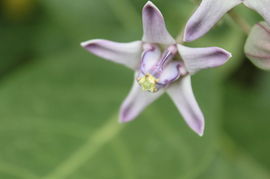CALOTROPIS GIGANTEA
description & usage
This shrub abounding in milky juice, is found chiefly in waste lands in Lower Bengal, Himalayas, Punjab, Assam,, South India, Ceylon, Singapore, Malay Islands and South China. C. procera and C. gigantea, both pass by the name of "Madar" ; C. procera is the smaller one . "Two varieties of the plant are described by Sanskrit writers, viz ; the white-flowered or "alarka" and the purple or red-flowered or "arka" . It is medium sized shrub and its bark is pale. The leaves are heart shaped and pointed on the tip. The seeds are ovate with white silky coma or floss.
Uses :
Leprosy, Constitutional syphilis, Mercurial cachexia, Syphilitic and idiopathic ulcertaions, Dysentery, Diarrhoea, chronic rheumatism.
How to Use:
Mixed with honey it is used in aphthae of the mouth and with a piece of cotton wool it is inserted into hollow carious teeth to cure tooth-ache ; Hakim Mir Abdul Hamid strongly recommends it in leprosy, hepatic and spleen enlargements, dropsy and worms. Fresh leaves slightly roasted, are also used as application to painful joints, swellings etc. Oil in which leaves have been boiled, is applied to paralysed parts. A fluid extract of leaves (I in I) given in doses of 10 to 20 grains and in 1 to 5 drops in intermittent fever during intermission will cut off the paroxysm more effectually than quinine. Dried flowers in 1 to 2 grain doses with sugar are given in leprosy, secindary syphilis and gonorrhoea with milk diet.
Parts Used:
Roots, root-bark, leaves
Taste:
Bitterness
Action:
Althelmentic, alterative, laxative
Uses :
Leprosy, Constitutional syphilis, Mercurial cachexia, Syphilitic and idiopathic ulcertaions, Dysentery, Diarrhoea, chronic rheumatism.
How to Use:
Mixed with honey it is used in aphthae of the mouth and with a piece of cotton wool it is inserted into hollow carious teeth to cure tooth-ache ; Hakim Mir Abdul Hamid strongly recommends it in leprosy, hepatic and spleen enlargements, dropsy and worms. Fresh leaves slightly roasted, are also used as application to painful joints, swellings etc. Oil in which leaves have been boiled, is applied to paralysed parts. A fluid extract of leaves (I in I) given in doses of 10 to 20 grains and in 1 to 5 drops in intermittent fever during intermission will cut off the paroxysm more effectually than quinine. Dried flowers in 1 to 2 grain doses with sugar are given in leprosy, secindary syphilis and gonorrhoea with milk diet.
Parts Used:
Roots, root-bark, leaves
Taste:
Bitterness
Action:
Althelmentic, alterative, laxative


